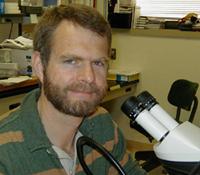Shannon J. Odelberg

Research Associate Professor of Internal Medicine
Adjunct Assistant Professor of Neurobiology and Anatomy
Molecular Neuroscience
Cellular Neuroscience
Developmental Neuroscience
e-mail: sodelber@genetics.utah.edu
B.S. 1980, Weber State College; Ph.D. 1987, Medical College of Virginia; Postdoctoral
Associate 1987-1993, and Research Associate, 1994-1996, University of Utah
RESEARCH:
My laboratory research focuses on two main areas of research: 1) the role of the small GTPase ARF6 in tumor establishment, growth, and metastasis and in vascular permeability and inflammation and 2) the molecular and cellular basis of regeneration and cellular plasticity.
The role of the small GTPase ARF6 in tumor establishment, growth, and metastasis and in vascular permeability and inflammation
The activation of the small GTPase ARF6 has been implicated in promoting several pathological processes related to tumor establishment, growth, and metastasis, vascular leak, and inflammation. We have shown that ARF6 controls the trafficking of key oncogenic proteins to the appropriate intracellular locations where they enhance signaling. For example, in uveal melanoma, activation of ARF6 promotes the trafficking of oncogenic GNAQ from the plasma membrane to cytoplasmic vesicles where PLC/PKC, Rho/Rac, YAP, and b-catenin signaling are enhanced. Inhibition of ARF6 reverses the trafficking process, decreases signaling, and reduces tumor establishment and growth in an orthotopic xenograft mouse model of uveal melanoma, suggesting that ARF6 might be a good therapeutic target for this deadly cancer. We have also shown that inhibiting ARF6 in cutaneous melanoma reduces metastasis to the lungs in a xenograft mouse model of cutaneous melanoma and that ARF6 activates PIK3 in melanoma to induce prometastatic state. We continue to study these tumors, while expanding our efforts to also include the role of ARF6 in other cancers, such as glioblastoma and malignant sarcomas.
ARF6 also plays a role in vascular stability and inflammation. The activation of ARF6 promotes vascular instability and fluid leak into surrounding tissues during inflammatory processes, while the inhibition of ARF6 stabilizes the vasculature and reduces harmful vascular leak. Using cell culture assays and preclinical animal models, we have shown that inhibiting ARF6 activation in diseases and disorders associated with vascular leak and chronic and acute inflammation, such as diabetic retinopathy, rheumatoid arthritis, acute lung injury (a model for acute respiratory distress syndrome), and sepsis, reduces pathology and enhances survival rates in the lethal conditions. We have shown that, similar to its role in cancer, activation of ARF6 promotes the trafficking of key proteins to appropriate intracellular locations where signaling is enhanced. We continue to explore the molecular mechanisms by which ARF6 exerts its effects on such a diverse array of inflammatory processes.
Molecular and cellular basis of regeneration and cellular plasticity
For many years, my laboratory focused on the cellular and molecular basis of regeneration in newts. A newt has the remarkable ability to regenerate lost or injured structures and organs, including its limbs, tail, spinal cord, heart ventricle, retinas, lenses, optic nerves, upper and lower jaws, intestines, and parts of the brain. Many of the progenitor cells required for regeneration are created de novo by the dedifferentiation of mature cells located near the site of injury. This degree of cellular plasticity is unique to organisms with marked regenerative abilities and is not observed in mammals. Over the years, my laboratory and our collaborators have identified several factors involved in inducing cellular plasticity and have shown that a transitional extracellular matrix can induce cell behaviors that are required for normal regeneration, including cell dedifferentiation, proliferation, and migration. We have also studied spinal cord regeneration in newts and have shown that meningeal and glial cells establish a permissive environment for axon regeneration after a severe spinal cord injury.
